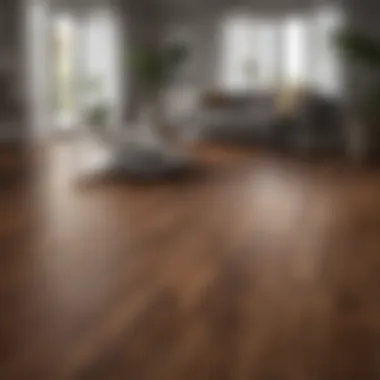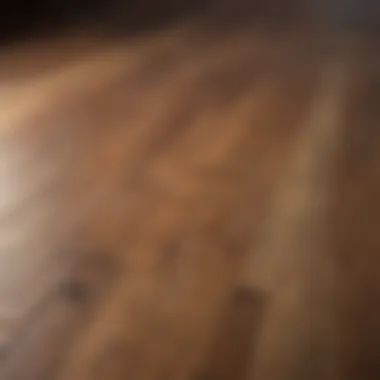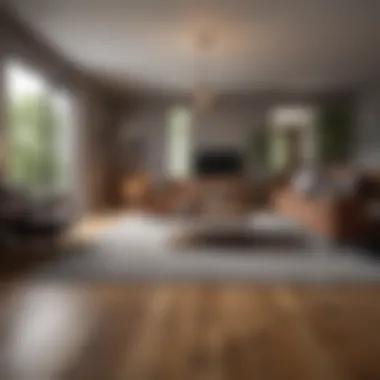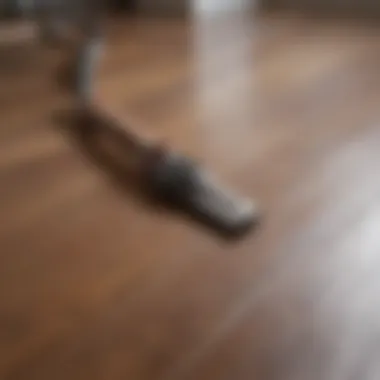Choosing the Ideal Hardwood Floor for Your Living Room


Intro
Selecting the appropriate hardwood floor for your living room is a crucial decision that impacts both the aesthetic and functional aspects of your home. As a central gathering place for family and friends, the living room deserves a floor that is not only attractive but also durable and easy to maintain. This comprehensive guide will delve into the fundamental factors to consider when choosing hardwood flooring, including durability, style, types of wood, and installation methods. Emphasizing current trends and maintenance practices, it aims to equip homeowners and designers with the information necessary to curate a beautiful and practical living space.
Design Inspiration
Current Trends in Interior Design
The realm of interior design is ever-evolving, reflecting shifts in lifestyle and preferences. Currently, there is a noticeable trend towards minimalism and sustainability. Homeowners are increasingly favoring natural finishes that showcase the wood’s true characteristics, favoring colors that work well with a variety of decorations. Moreover, reclaimed wood has gained popularity, not only for its unique charm but also for its eco-friendly appeal.
"Choosing the right flooring can significantly enhance your living room's overall vibe and comfort."
Color Schemes and Palette Ideas
The color of your hardwood floor plays a pivotal role in setting the tone for the living room. The choice between light, medium, or dark shades can create a distinct atmosphere. Light colored floors often make the space feel larger and airier, while darker shades lend elegance and warmth. It is important to find a balance with wall colors and furniture to ensure a cohesive look. Here are a few combinations to consider:
- Light Floors: Pair with soft pastels like mint green or pale yellow for a fresh look.
- Medium Floors: Work well with earth tones such as terracotta or sage green.
- Dark Floors: Complement with jewel tones like emerald or deep blue for a touch of luxury.
The End
In summary, when selecting the best hardwood floor for your living room, it is essential to blend style with practicality. Understanding current trends in interior design, along with color schemes, can significantly influence the decision-making process. Ultimately, the right choice will enhance the living space, reflecting personal taste while ensuring durability and ease of maintenance. Stay tuned for deeper insights into wood types and installation techniques in the upcoming sections.
Understanding Hardwood Flooring
Understanding hardwood flooring is essential for making informed choices when selecting the best flooring for a living room. This type of flooring not only impacts the aesthetics of the space but also its functionality, durability, and overall ambiance. In this section, we will explore the definition and characteristics that define hardwood, as well as the reasons it is a preferred choice in many homes.
Definition and Characteristics of Hardwood Floors
Hardwood flooring is made from natural wood, offering a variety of colors, textures, and grain patterns. It is derived from deciduous trees like oak, maple, and cherry. Each type of wood boasts specific characteristics, including hardness, grain, and appearance. The manufacturing process includes cutting the wood to desired thickness and applying finishes that enhance its durability. Solid hardwood is milled from a single piece of timber, whereas engineered hardwood consists of multiple layers, making it more stable in fluctuating environmental conditions.
It's important to understand these characteristics because they influence how the floor will perform in a living space. Solid hardwood, for instance, can be sanded and refinished multiple times, while engineered alternatives may have limitations based on the thickness of their top layer. This choice affects not only the lifespan but also how the flooring will respond to humidity and temperature changes.
Advantages of Hardwood Flooring in Living Rooms
Opting for hardwood flooring in living rooms holds several advantages. One of the most significant is its timeless appeal. Hardwood floors can elevate the look of any room, providing an elegant backdrop for various design aesthetics.
- Aesthetic Versatility: The natural beauty of wood allows for a wide range of design possibilities. Whether you prefer a rustic or contemporary look, hardwood accommodates both styles.
- Durability: Hardwood is sturdy and long-lasting, often attracting a higher resale value. If cared for properly, it can last generations, making it a wise investment.
- Easy Maintenance: Regular sweeping and occasional damp mopping suffice for maintenance. Unlike carpets, hardwood does not trap allergens or dust, contributing to a healthier indoor environment.
- Comfort: Hardwood floors can feel warmer than tiles or stones, especially when complemented with area rugs.
In summary, understanding hardwood flooring's definition and its advantages offers homeowners and design enthusiasts critical insights that help in selecting the optimal type for their living room. Hardwood not only influences the overall aesthetics but also shapes the functionality and comfort of the living space.
Choosing the Right Type of Hardwood
Selecting the appropriate type of hardwood flooring is essential in the context of your living room. This decision impacts the room's aesthetics, durability, and functionality. Living rooms are spaces meant for gatherings, relaxation, and entertainment. Therefore, the choice of flooring must align with your lifestyle, budget, and design preferences.
Hardwood flooring comes primarily in two forms: solid hardwood and engineered hardwood. Understanding these variations can help make an informed choice. Each type has distinct characteristics that cater to different needs and environments.
Solid Hardwood vs. Engineered Hardwood
Solid hardwood flooring consists entirely of natural wood. It is known for its beauty and longevity. One significant benefit of solid hardwood is that it can be sanded and refinished multiple times, prolonging its life. However, it is also susceptible to moisture and temperature fluctuations. Thus, it may not be suitable for areas prone to humidity.
On the other hand, engineered hardwood features multiple layers of wood, with a top layer crafted from solid wood. This construction offers more stability, making it less prone to warping or expansion from humidity. Engineered hardwood can be an excellent choice for living rooms located above ground. Furthermore, it can handle more moisture than solid hardwood but may not fully replicate the feel of solid wood underfoot.
Popular Wood Species for Living Rooms
Choosing the right wood species significantly influences the overall atmosphere of your living room. Some distinct types stand out for their appearance and characteristics.


Oak
Oak is a prevalent choice due to its durability and timeless look. It has a distinctive grain pattern and is available in a variety of finishes. The key characteristic of oak is its hardness, making it suitable for high-traffic areas. Its natural variation in color ranges from light to dark, providing flexibility in design. However, oak tends to scratch and dent, so proper care is necessary to maintain its appearance.
Hickory
Hickory is one of the hardest domestic woods available. Its unique feature is the dramatic color variation, ranging from cream to dark brown. This species provides a rustic or country vibe, making the living room feel inviting. The key advantage of hickory is its resilience against wear. However, its hardness can make installation more challenging, requiring specialized tools.
Maple
Maple is a lighter wood known for its smooth and consistent grain. It is less prone to scratches and provides a sleek aesthetic suitable for modern interiors. The advantageous characteristic of maple is its ability to complement a variety of decor styles. However, it is slightly softer than oak and hickory, necessitating careful treatment to prevent damage.
Cherry
Cherry wood is cherished for its rich, warm tones that deepen over time. This species brings a touch of elegance to any living room. The key characteristic of cherry is its fine grain and smooth texture, making it desirable for high-end designs. Although cherry can be more expensive, its aesthetic appeal and longevity make it a worthwhile consideration. However, like other hardwoods, it requires maintenance to keep it looking its best.
By addressing these elements, homeowners can make a more educated choice on the type of hardwood that fits their living room needs, ultimately enhancing the overall living environment.
Aesthetic Considerations
Aesthetic considerations play a pivotal role when selecting hardwood flooring for a living room. This space often reflects the personality and style of the home. It serves as a gathering point for family and friends, so its appearance should resonate with comfort, warmth, and elegance. Understanding various aesthetic elements is crucial in making an informed decision. From color choices to patterns and textures, these factors influence the overall ambiance.
Color Choices for Hardwood Floors
Choosing the right color for hardwood floors significantly impacts the room's look.
Light vs. Dark Shades
Light and dark shades of hardwood flooring have distinct effects on the space. Light shades, like maple or ash, can create a sense of openness. They reflect more natural light, making smaller spaces feel larger. Conversely, dark shades, such as walnut or ebony, impart a sense of richness and sophistication. They tend to absorb light, which can create a cozy atmosphere.
Key Characteristics of Light and Dark Shades:
- Light Shades: Open, airy, and versatile
- Dark Shades: Elegant, dramatic, and intimate
Both choices are beneficial depending on the desired aesthetic. Light floors suit modern or minimalist styles, while dark floors complement traditional or rustic designs. However, dark floors may show dust and scratches more easily, requiring a more diligent maintenance routine.
Stained Finishes
Stained finishes are another vital component when considering aesthetics. They enhance the natural beauty of the wood grain while providing an opportunity for customization. Stains come in various hues, allowing homeowners to match their flooring with existing decor effortlessly.
Key Characteristics of Stained Finishes:
- Enhance wood grain
- Wide range of colors available
Stained finishes can elevate the visual appeal of hardwood floors. They add depth and character, making each plank unique. It's important to note that some stains may fade over time, necessitating touch-ups or refinishing to maintain the original look.
Patterns and Textures
Patterns and textures present additional layers of aesthetic appeal to hardwood flooring. They contribute to the overall tactile experience within the living space.
Distressed Floors
Distressed floors replicate the appearance of aged wood, lending a vintage charm to the home. This style is particularly popular in farmhouse or rustic decor. The unique scratches and imperfections evoke history and character, providing a narrative to the space.
Key Characteristics of Distressed Floors:
- Vintage appeal
- Individual character


However, they may not suit everyone’s taste. The rough texture can feel less formal and may clash with contemporary furnishings. Choosing distressed wood requires consideration of the overall interior design style.
Smooth Finishes
Smooth finishes present a polished, refined look suitable for modern or classic designs. The even surface enhances the elegance of the wood while allowing for easy maintenance. This makes it a practical option for busy households.
Key Characteristics of Smooth Finishes:
- Polished appearance
- Easy to clean
While smooth finishes offer sophistication, they might lack the character found in distressed options. Homeowners should weigh their personal style preferences against practical considerations when deciding.
Understanding these aesthetic aspects ensures that the hardwood flooring aligns with both the functionality and visual appeal of the living room. This integration will result in a harmonious and welcoming environment that reflects the homeowner's identity.
Durability and Maintenance
The choice of hardwood flooring for your living room is not solely about appearance. Durability and maintenance play vital roles in ensuring that your investment sustains over time. Living rooms are often high-traffic areas, subject to wear and tear. This makes it essential to select a flooring material that can withstand daily use while maintaining its aesthetic appeal. Durable hardwood flooring offers not just resilience but also an enduring beauty that can enhance the value of your home. Therefore, understanding how to manage both durability and maintenance effectively is crucial.
Understanding Hardness Ratings
Hardness ratings reflect the ability of wood to resist denting and wear. The Janka hardness test is the standard used for measuring this aspect. This test determines how much force is needed to embed a steel ball into the wood. For instance, species like Oak and Hickory rank high on the scale, making them suitable for areas with heavy foot traffic. Choosing hardwood floors with high hardness ratings can significantly reduce the chances of damage, thus extending the life of your flooring.
Preventative Care and Maintenance Tips
Preventative care and maintenance are cornerstones in preserving the quality of hardwood floors. Consistent attention to these areas can prevent larger issues from arising.
Regular Cleaning Practices
Regular cleaning practices play an essential role in maintaining hardwood floors. Sweeping or vacuuming frequently helps remove dirt and debris that can scratch the surface. A damp mop with a cleaning solution specifically designed for hardwood is often recommended to avoid excess water that can lead to warping. The key characteristic of this practice is its simplicity. It does not require heavy equipment or specialized knowledge, making it an accessible option for homeowners. The advantage of regular cleaning is that it helps in maintaining the floor’s gloss and prevents long-term damage.
Protective Measures
Protective measures are also critical in ensuring the durability of your hardwood flooring. Area rugs can protect high-traffic zones from scratches and dents. Felt pads under furniture legs further eliminate the risk of scratching. One key aspect is that these guards are proactive, meaning that they can significantly mitigate potential damage before it occurs. Their unique feature lies in their invisibility; with proper placement, they can provide protection without altering your room’s aesthetics. However, some homeowners may find it cumbersome to remember to adjust these measures regularly, especially as furniture is rearranged, which can pose a slight disadvantage.
Proper maintenance and care can double the lifespan of your hardwood floors while keeping them looking new for years.
Installation Options
Selecting installation options for hardwood flooring is a crucial aspect of the overall flooring experience. The method you choose impacts not just the aesthetics but also the longevity, maintenance, and practicality of the floor. Understanding these aspects helps homeowners and designers to make informed decisions.
DIY Installation vs. Professional Services
Choosing between DIY installation and hiring professional services is a significant consideration. DIY installation may seem enticing due to cost savings. However, the complexity of installation can lead to mistakes that may not be easily corrected. For example, improper alignment with the walls or uneven floors can result in additional expenses later on.
Professional installation provides expertise that can ensure the job is done flawlessly. Professionals are equipped with proper tools and techniques that guarantee durability and adherence to warranty requirements. Furthermore, with professionals, you often receive a warranty for their work, adding peace of mind to the investment made.
Installation Methods
Different installation methods can further influence the overall outcome of your hardwood flooring.
Nailing
Nailing is a traditional method where hardwood planks are secured to a wooden subfloor using nails. This technique is particularly beneficial for solid hardwood floors as it provides a strong hold. One key characteristic of nailing is that it allows for natural expansion and contraction of the wood, reducing the risk of warping. However, nailing requires specific tools and skills. Homeowners should consider if they have the necessary experience or if they should consult a professional for this installation.
Glue-down
The glue-down method involves adhering the hardwood planks directly to the subfloor using a strong adhesive. One of the benefits of this method is that it can be used on various subfloors, including concrete, making it versatile. The strong bond reduces noise and can create a softer feel underfoot. However, glue-down installations might take longer to set as they require adequate curing time before foot traffic can resume. This method can also be messy if not handled carefully, necessitating a thorough cleanup.


Floating
Floating installation differs from the other methods because the hardwood planks do not get attached to the subfloor. Instead, they are interconnected by a tongue-and-groove mechanism, allowing them to sit "floating" over an underlayment. This method is popular due to its speed and ease of installation. A significant advantage of floating floors is that they can be installed over almost any existing flooring, further eliminating the need for costly repairs or removal. However, care must be taken with moisture levels, as floating floors can be more susceptible to expansion and contraction with changes in humidity.
Understanding these installation options allows homeowners to select not just a visually appealing floor but also one that meets their lifestyle and maintenance preferences.
Trends in Hardwood Flooring
Hardwood flooring is a dynamic and evolving aspect of interior design. The trends in hardwood flooring shape how homeowners interact with their living environments. Awareness of these trends is crucial for making informed decisions that align with personal style and functionality. This section discusses the current design trends and sustainable choices within hardwood flooring, offering insights into how these aspects can enhance the living room experience.
Current Trends in Design
In the realm of hardwood flooring, design trends shift frequently. Homeowners are increasingly leaning toward lighter finishes. Light oak and ash wood provide an airy feel, creating a sense of space. Alternatively, dark woods like walnut are often chosen for their warmth and richness, contributing to a cozy ambiance. Striking a balance between light and dark is essential when selecting a floor color, making it compatible with existing furnishings.
Another popular trend is the use of wider planks. Wider boards give a more modern aesthetic and help to reduce the appearance of seams, creating a seamless look. This choice works well in open-concept living spaces. Additionally, patterns like herringbone or chevron layouts are making a comeback. These intricate designs not only enhance visual interest but also elevate the overall character of a room.
Recent studies have shown that textured finishes are also gaining popularity. A trend towards hand-scraped or distressed flooring caters to those wanting a rustic or artisanal touch, subtly drawing attention without overwhelming the space.
"Current trends reflect a shift in homeowner preferences towards personalization and expressive design elements."
Sustainable and Eco-friendly Choices
Sustainability is becoming increasingly important in the selection of hardwood flooring. Today’s consumers are more aware of environmental impact. Sustainable hardwood options are often derived from responsibly managed forests. Popular certifications include the Forest Stewardship Council (FSC) label, which ensures that the wood is sourced in a manner that contributes to ecological balance.
Moreover, reclaimed wood is a growing choice among eco-conscious homeowners. This type of flooring not only preserves our forests but adds unique character to a space due to its history. Options such as reclaimed oak or barn wood can provide both aesthetic and environmental benefits.
Additionally, many manufacturers are shifting towards low-VOC finishes. These finishes are crucial in reducing indoor air pollution and improving overall air quality. Homeowners are encouraged to look for flooring products that prioritize health and sustainability, contributing positively to their living environment.
Choosing the right hardwood floor that aligns with modern trends can significantly enhance your living experience, all while being kind to the planet.
Cost Considerations
When selecting hardwood flooring for your living room, understanding the costs involved is crucial. The investment not only affects your budget but also determines the long-term satisfaction with your flooring choice. Both material and installation costs can vary significantly, impacting the overall value of your home.
To make an informed decision, it is essential to consider various factors that contribute to the price of hardwood floors. These factors can range from the type of wood selected to the methods used during installation. Having a clear budget will guide you through options and prevent overspending.
"The cost of hardwood flooring is not only about the square footage; it's about understanding the entire process from selection to installation."
Pricing Factors for Hardwood Flooring
Several elements influence the price of hardwood flooring. These can be categorized into materials, type, and supplier.
- Type of Wood: Solid hardwood generally costs more than engineered hardwood. Popular species like oak, hickory, maple, or cherry can also have different price points. For instance, oak tends to be more affordable than exotic hardwoods like mahogany.
- Finish and Treatment: Pre-finished floors may save time, but they could be pricier than unfinished options. Consider whether you desire a specific stain or finish and its impact on the pricing.
- Area of Coverage: The larger your living room, the more material you require. Measure the area accurately to estimate how much flooring you need, thus directly affecting the total cost.
- Supplier Pricing: Prices can vary between different retailers. Always compare offers and read customer reviews before making a purchase.
Budgeting for Installation and Maintenance
Apart from the direct costs of the materials, budgeting for installation and maintenance is vital. Homeowners often overlook these components until it becomes a financial burden.
- Installation Costs: Professional installation usually adds a substantial expense but can ensure proper fitting and longevity. DIY is an option too, yet it requires skill and tools. Consider the complexity of installation methods like nailing, glue-down or floating when making decisions.
- Maintenance Budget: Hardwood floors require regular upkeep to maintain their aesthetic appeal. Allocate funds for cleaning supplies, refinishing if necessary, and repairs. Developing a routine can extend the lifespan of your flooring, making it a worthy investment.
Finale
Selecting the right hardwood floor for your living room is not merely about aesthetics; it weaves into the very fabric of your home's ambiance. This discussion has traversed numerous facets of hardwood flooring, emphasizing how choices impact not only beauty but also functionality and lifespan. Understanding various wood types helps in making informed decisions. For instance, oak may offer durability, while maple can provide a modern touch.
"The floor acts as the base of your living space, influencing the harmony of the entire room."
Homeowners and designers both must weigh the importance of maintenance, costs, and installation methods. With engineered hardwood gaining momentum, knowing the pros and cons of each option sharpens your decision-making. Additionally, trends lean towards eco-friendly products, resonating with a growing consciousness about sustainability.
Key Takeaways for Selecting the Best Hardwood Floor
- Understand the Types: Solid and engineered hardwood come with distinct benefits. Solid wood is robust but might not perform well in humid environments. Engineered wood, on the other hand, offers a stable alternative that can be used in various settings.
- Select the Right Species: Choose a wood species that aligns with your lifestyle and tastes. For instance, hickory is tough, making it ideal for high-traffic areas, while cherry offers an elegant, warm appearance.
- Focus on Aesthetics: Consider the colors and finishes that complement your existing decor. Darker shades can create a cozy feel, whereas lighter tones tend to make spaces appear larger and brighter.
- Evaluate Durability and Care: Pay attention to the hardness rating of the wood. Species like oak or hickory have higher Janka ratings, indicating resilience. Regular care will prolong the life of your flooring and maintain its appeal.
- Installation Matters: Decide if you prefer DIY installation or hiring professionals. Different methods exist, such as nailing, glue-down, and floating, each suited for specific situations.
- Budget Accordingly: Understand the wider financial implications beyond just the floor cost. Installation and ongoing maintenance should be part of your overall budget.
Overall, hardwood flooring significantly influences the design narrative of your living room. The blend of practical considerations and aesthetic choices makes this process both essential and rewarding.



